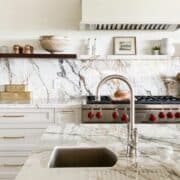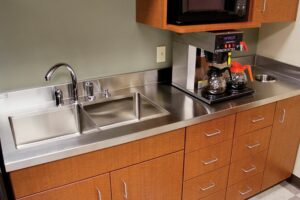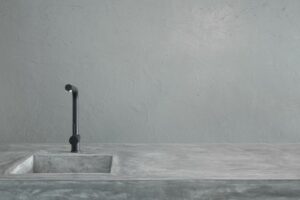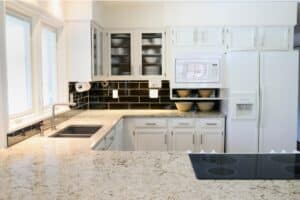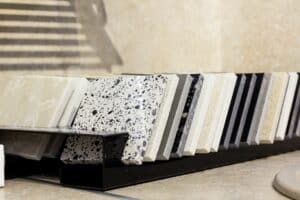Slate countertops excel in aesthetics, durability, and low maintenance. Their non-porous surface ensures easy cleaning, making them a versatile choice for kitchens, bathrooms, wet bars, backsplashes, and sinks.
Slate Countertop Lookbook
Slate Countertops: Advantages
- Easy to clean: Slate’s non-porous surface eliminates the need for sealing and is resistant to bacteria and mold.
- Highly stain-resistant: Among the most stain-resistant materials available.
- Heat resistant: Withstands high temperatures without damage.
- Less visible seams: Slate offers minimal visibility of seams compared to other materials.
- Customizable fabrication: Can be cut, drilled, and shaped to match countertops seamlessly.
- Versatile aesthetics: Available in various colors and patterns, fitting both rustic and classic kitchen designs.
Slate Countertops: Disadvantages
- Brittle and prone to chipping and cracking: Being a natural stone, slate is inherently brittle and can easily chip or crack if not handled with care.
- Varying quality of slate slabs: The quality of slate slabs can differ significantly between manufacturers, emphasizing the need for thorough research before purchasing.
- Scratches easily: Slate surfaces are susceptible to scratches, requiring cautious handling.
- Cannot be polished to a glossy shine: Unlike some materials, slate lacks the capability to achieve a glossy shine through polishing.
- Limited color options: Slate offers a restricted range of colors, with certain options potentially unavailable in specific areas.
How to Clean Slate Countertops?
For proper slate countertop care, weekly dusting and sweeping with a microfiber cloth minimize dust and surface scratches. Avoid abrasive cleaners, oil sprays, or those with lemon or vinegar, as they can wear away the stone.
Furthermore, steer clear of cleaners containing wax, as placing hot cookware on a slate countertop may melt the wax, causing stains on the stone.
To prevent water spots, use a damp cloth and a pH-neutral stone cleaner on slate surfaces. Wipe the slate counters dry after cleaning to deter mineral deposits and water stains.
Sealing Slate Countertops
Despite slate’s resistance to stains, it’s essential to seal these stone slabs. Reseal when water droplets no longer bead up after splashing. While sealers penetrating the slate offer superior protection, topicals wear down faster.
Sealing slate countertops immediately after installation is crucial for minimizing harm. Maintain and protect slate worktops with a natural stone cleaner, sealer, soft cloths, poultice, mineral oil, and an old towel.
FAQs
Is slate more affordable than granite?
Indeed, slate countertops are less costly than granite, marble, and other pricier materials. They also come at a lower price point compared to most concrete, quartz, or broken glass counters.
Is slate prone to breakage?
Despite its durability, slate can break if a heavy object is dropped on it, leading to potential shattering.
Is slate less expensive than quartz?
Yes, slate is generally more budget-friendly than quartz. Slate countertops offer a cost advantage over granite, marble, and other high-end materials, as well as being more affordable than most concrete, quartz, or broken glass counters.
Can hot pans be placed on slate?
Yes, but caution is advised as slate can heat up and become too hot to touch. It’s advisable to use a trivet or hot pad when putting hot pans on slate countertops.
Is slate cheaper than soapstone?
Slate and soapstone are typically in a similar price range. However, high-quality soapstone tends to be less expensive than high-quality slate.








